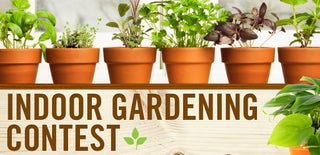Introduction: Grow Little Terrariums
Grow Little is a lively little company based in Paris that specializes in decorative, organic botanicals and landscapes that live and thrive under glass. These terrariums are living, original compositions that evolve over time. Each microcosm is unique, made lovingly by hand to bring nature’s poetry into the home. Grow Little also creates urban gardens on terraces and balconies and loves creative collaborations.
What is a Terrarium?
A terrarium is a collection of small plants growing in a transparent, sealed container. A
terrarium is a closed environment, and can actually be used to illustrate how an ecosystem works. Inside a terrarium’s walls, many different natural processes may be observed: photosynthesis, respiration, and the water cycle. The water in the terrarium is constantly recycled, passing from liquid form to gas and back again. As the moisture in the air condenses on the glass walls, it returns to the soil and is absorbed by the plants’ roots.
Supplies
Clear glass or plastic container
Small stones
Activated charcoal (from aquarium or orchid supply store) Sphagnum moss (optional)
Potting soil
Plants
Decorative objects (optional)
Choosing your container
Terrariums come in many different and creative shapes and sizes. Most terrariums are
made from a clear glass jar with a wide mouth. It is important to consider that the wider the opening of your container, the easier it will be to place the plants.
Choosing your plants
Often, terrariums are made with small mosses, lichens and ferns. However, there are several other types of plants that can be used, depending on the size of the terrarium, including begonias, miniature violets, coleuses, pilea (baby tears) and others. Plants need not be purchased, but can be collected from your yard and neighborhood. Get creative! For additional suggestions of plants, see resources below.
Building Your Terrarium
Place a thin layer (approx. 1 inch) of small stones in the bottom of the terrarium to help drainage.
Place a thin layer (approx. 1/2 inch) of activated charcoal over the stones. This acts as a filtration substrate and keeps the water cleaner.
Place a thin layer of sphagnum moss or a fine screen over the charcoal to act as a barrier to prevent settling of the soil. (Optional)
Place a layer of potting soil approximately 2” deep.
Make small holes for roots and carefully plant your plants in the soil.
Finishing touches – add ornaments or decorations to give your terrarium a special
theme. (Optional)
Lightly mist with water, approximately 10 sprays to the soil and sides of the jars.
Close container tightly with lid or cover.
Caring for your Terrarium
The two most important factors you must consider when caring for your terrarium are sunlight and water.
Sunlight: Place your terrarium in a bright area with indirect sunlight, such as a windowsill. Because the terrarium is a closed system, it can get too hot if it is in direct sun and the plants may burn.
Water: A properly maintained terrarium can go for weeks or months without needing water. As the terrarium heats up, water will be pulled up from the rocks and soil to the top of the container where it will form a mist and then drip back down to water the plants. You should be able to see some mist on the sides of the container as well as some fog inside; however, if the sides are constantly wet, and there is so much condensation that you cannot see your plants, then you will need to open the top of the container temporarily to allow it to dry.
Pruning: Plants may need to be pruned to keep them small enough to fit the container. You can do this with a pair of scissors.
Fertilizer: You should not add any fertilizer to your terrarium. The goal is to keep the plants very small, so you do not want to encourage rapid growth. The plants will get the nutrients they need from the soil.

Participated in the
Indoor Gardening Contest









